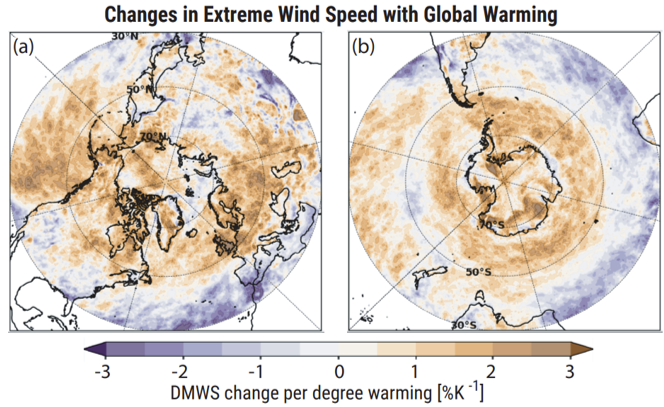Poleward Intensification of Midlatitude Extreme Winds Under Warmer Climate
npj Climate and Atmospheric Science
Authors: Emanuele Silvio Gentile, Ming Zhao, Kevin Hodges DOI: 10.1038/s41612-023-00540-x
Focusing on climate-induced changes in winds, I investigated how midlatitude cyclones impact the global distribution of extreme wind speed events, defined as those exceeding the climatological 99th percentile, across both hemispheres in a warmer climate. The study uses the state-of-the-art GFDL atmospheric climate model AM4, with a grid spacing of approximately 50 kilometers, covering the period from 1949 to 2019. The authors analyzed scenarios representing present-day climate conditions and an idealized future projection characterized by global warming conditions with a uniform sea surface temperature (SST) increase of 2K. The findings of the investigation yield several key insights: there is an increase in near-surface extreme wind speeds of up to 3%/K towards the polar regions, while there is a corresponding decrease in the midlatitudes. There is a clear trend of midlatitude cyclones associated with extreme wind speeds migrating towards higher latitudes. One particularly notable finding is the interaction between midlatitude cyclones and extreme wind events. Despite an overall reduction in the number of midlatitude cyclones by approximately 4% in the warmer climate, there is a significant increase in the proportion of cyclone-associated extreme wind speeds by 10%. This highlights the changing nature of extreme wind occurrences in a warmer climate.
Additionally, the study identifies specific regions, such as Northwestern Europe, the British Isles, and the West Coast of North America, as areas of heightened concern due to the amplified impacts of cyclone-associated extreme winds in a warmer climate, which in turn has socio-economic consequences.
While the research findings provide critical insights into the complex interplay between midlatitude cyclones, extreme wind events, and climate change, the authors emphasize the importance of understanding the dynamics of midlatitude cyclones amidst human-induced climate change. This understanding is crucial for developing effective climate adaptation strategies and mitigating associated risks. The study also highlights the importance of extreme wind events in vulnerable areas but it acknowledges limitations, including the simplified assumption of uniform SST warming and the overlooked decline in sea-ice cover, which necessitate further examination of the complexities of cyclonic activity in a warming future.

Enjoy Reading This Article?
Here are some more articles you might like to read next: